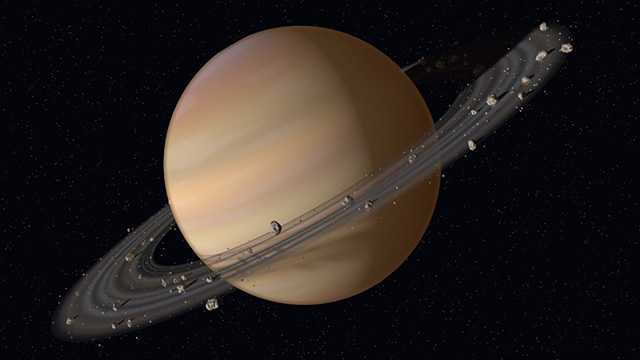Most people are aware that Saturn, the sixth planet from the Sun, is famous for its magnificent rings. However, not everyone is aware of the actual color of Saturn itself. Even with a basic telescope or a pair of astronomical binoculars, one can observe that Saturn displays a wide range of hues, ranging from pale yellow to orange.
Saturn’s General Characteristics
There are two main theories regarding the origin of Saturn:
- The contraction theory suggests that Saturn, along with the other planets, formed from massive “clumps” in the gas and dust disk during the early stages of the solar system’s development.
- The accretion theory proposes that the formation of the solar system occurred in two stages. The first stage involved the formation of solid, dense celestial bodies, known as the planets of the Earth group. The second stage involved the formation of gas giants, including Saturn, from the primary protoplanetary cloud.
Key characteristics of Saturn include:
- Equatorial radius: 60,000 kilometers
- Polar radius: 55,000 kilometers
- The mass of the object is equal to 500 squillion tons (10 to the 21st degree).
- The average density of the object is less than 0.7 g/cm³.
- The linear speed of rotation around its axis is 9.87 km/s (at the equator).
- The axial rotation period of the object is 10.5 Earth days.
- The average distance of the object from the Sun is 1.4 billion km.
- The period of rotation around the Sun is 378 Earth days.
- The orbital velocity of the object is 9.79 km/s.
The atmosphere of the planet
On Saturn, the air is composed of a combination of hydrogen and helium, along with a small amount of water vapor, ammonia, and various hydrocarbons.
The distinct yellow hue of Saturn is caused by the presence of white ammonia crystals that settle on the upper layers of the reddish-brown clouds formed by a mixture of ammonium sulfide and water vapor.
Saturn’s Strong Winds
Recent studies conducted by the interplanetary program “Voyager” have confirmed the existence of powerful winds on Saturn, reaching speeds of up to 500 m/s. These winds primarily blow from west to east, aligning with the planet’s axial rotation.
The equator experiences the most intense air movements, while the strength of the winds weakens as we move towards the poles. Additionally, there are atmospheric currents that flow from east to west. This circulation pattern is observed not only in the upper layer of the atmosphere but also extends to a depth of at least 2,000 kilometers.
The Voyager 2 spacecraft also demonstrated that the winds in the north and south hemispheres of Saturn are symmetrical in relation to the equatorial line. This discovery has led scientists to speculate about a possible connection between these air currents closer to the planet’s surface. However, further investigation is needed to understand this phenomenon beneath Saturn’s visible atmosphere.
Saturn’s atmosphere is often the site of powerful and stable hurricanes, similar to cyclones and anticyclones found on other gas giants in the solar system. One notable example is the Great White Spot, which occurs in the northern hemisphere every 30 years during the summer solstice.
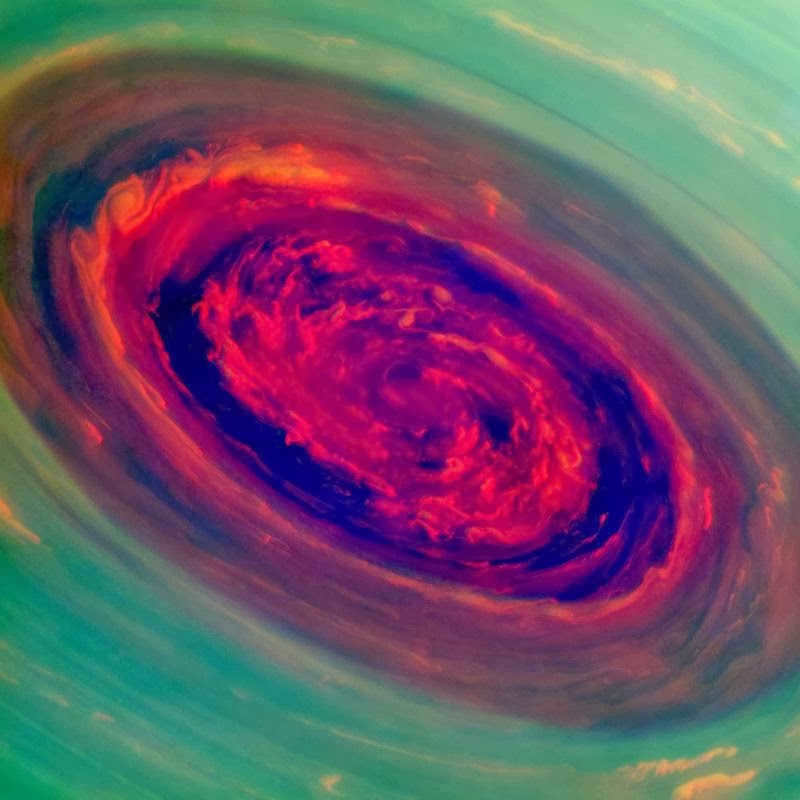
The primary components of Saturn’s ring structure
Studies conducted by interplanetary missions have confirmed that all four gas giant planets in the solar system (Jupiter, Saturn, Uranus, Neptune) possess rings. However, it is only Saturn’s ring system that is incredibly striking and easily visible from Earth. These formations are not solid; instead, they consist of numerous miniature celestial bodies that orbit the planet within its equatorial plane.
Saturn is adorned with a total of seven rings, consisting of three major rings and four minor rings. Each of these rings is adorned with a layer of cosmic dust, which reflects the light emitted by the planet.
The rings exhibit various colors. For instance, the innermost ring, located closest to the planet, appears grayish-black. The outermost part of the major rings has a yellowish-gray hue, while the middle ring contains areas of both white and yellowish-white.
The Color of Saturn’s Surface
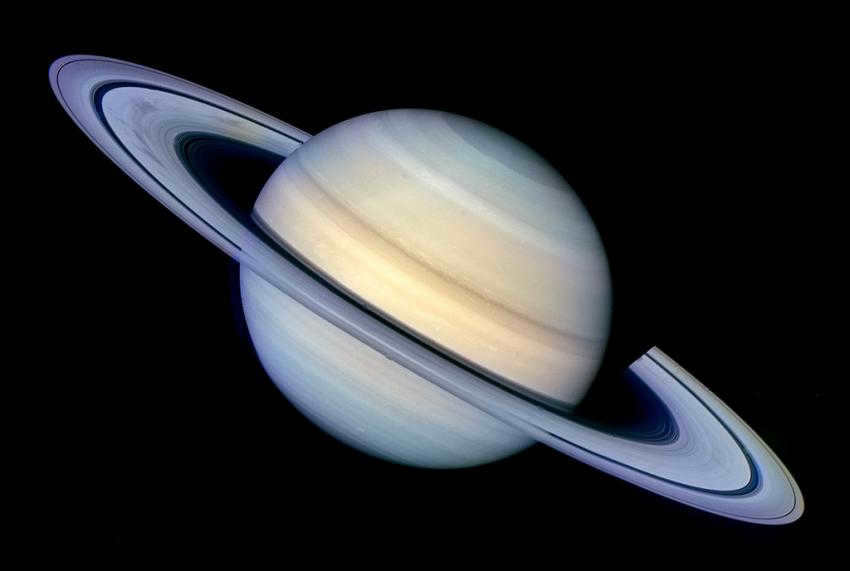
Saturn’s disk is characterized by a subtle yellow tint. Despite being one of the most vibrant and captivating celestial objects in our solar system, it appears somewhat faded when compared to its neighboring planet, Jupiter.
Similar to Jupiter, Saturn also exhibits streaks on its surface, although they are not as prominent. This could be due to the presence of clouds in the lower atmospheric layers, obscuring their visibility.
The surface of Saturn is not uniformly colored, as it displays distinct belts of various hues:
- Yellowish gray polar caps
- Grayish-brown equatorial region
- Yellowish-white mid-latitudes
Additionally, some of Saturn’s moons, such as Titan, also exhibit a yellow hue.
Gallery of Images
Only professional astronomical equipment is capable of fully observing the vibrant colors of Saturn. The Hubble Space Telescope or space probes dedicated to interplanetary exploration would provide even more detailed views. The Cassini spacecraft and other observatories have already captured stunning images of Saturn’s delicate cloud cover, swirling storms, and captivating colorations.
The striped pattern located near Saturn’s equator is particularly intriguing, and the large formations on the planet’s surface represent long-lasting storms. While some images depict Saturn as blue in color, scientists have determined that this is merely an optical illusion caused by the scattering of light.
When it comes to determining the color of planets, the use of advanced astronomical tools such as earth observatories and the Hubble Space Telescope still fails to provide a conclusive answer.
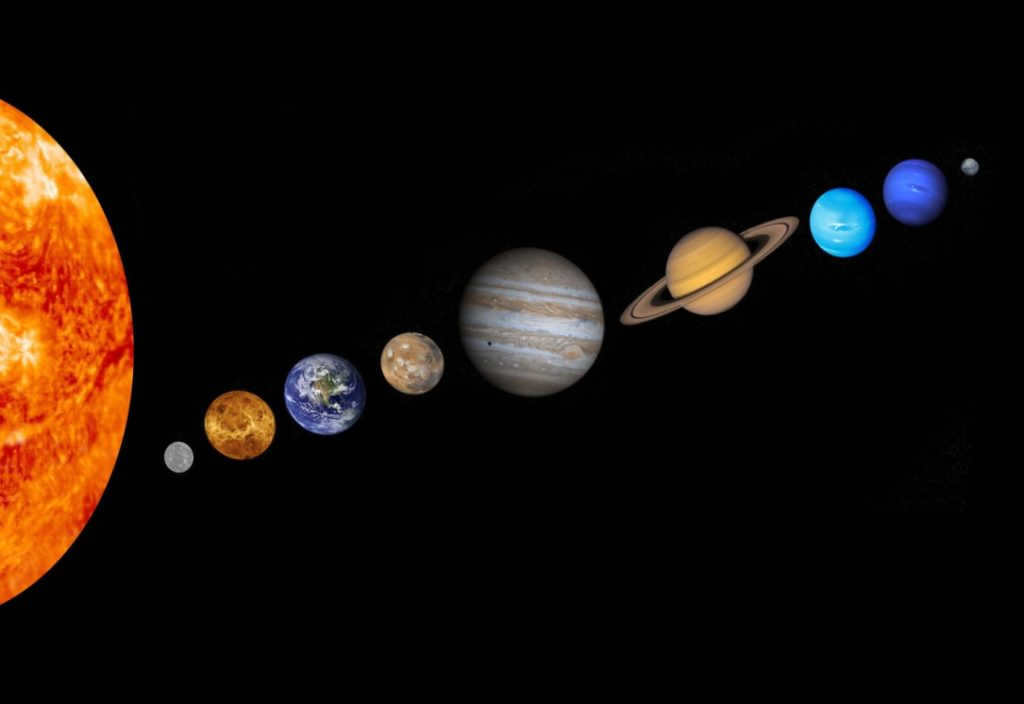
Factors influencing the color of planets
Planets often appear differently in photographs from various sources, with variations in brightness and even completely different shades. These differences can be attributed to factors such as observation angle, optical instrument capabilities, and the use of light filters in photography and videography.
Color perception is subjective, but there are generally accepted color descriptions for the solar planets:
- Mercury – a dull dark gray with no discernible dark spots;
- Venus – characterized by a pale yellow atmosphere and a brownish-red surface, although it appears as a bright white star from Earth;
- Earth appears light blue due to the abundance of water on its surface and the presence of an oxygen-rich atmosphere;
- Mars has a yellowish-brown color with hints of gold, green, and brown, and its atmosphere contains mineral dust particles (hematite and magnetite) that give the planet a reddish hue;
- Jupiter displays alternating areas of light yellow and reddish-brown stripes;
- Saturn appears pale yellow with thin orange streaks in its equatorial region, which can be attributed to the high concentration of ammonia in its atmosphere;
- Uranus has a greenish-blue color due to the presence of methane and other simple hydrocarbons in its atmosphere;
- Neptune has a deep blue color, even more intense than Uranus, with dark blue patches caused by giant atmospheric vortices.
Pluto, formerly classified as a planet, has a delightful light brown shade attributed to its dirty ice crust and rocky surface.
The Color of Jupiter’s Surface
Jupiter, a celestial body in our solar system, does not have a proven solid surface. It is believed to have an ocean of liquid metallic hydrogen beneath its atmospheric layer, which is not visible due to the dense clouds. As a result, the color of Jupiter can only be determined by its atmosphere.
There is much debate about the color of Jupiter, as even in natural color images, it appears inconsistent and resembles a speckled and striped sphere. Further questions arise when analyzing images taken with different light filters.
However, the color of the celestial body is not influenced by its period of revolution around the Sun or other astronomical characteristics. What truly matters is the composition of its atmosphere and the storm systems that take place within it.
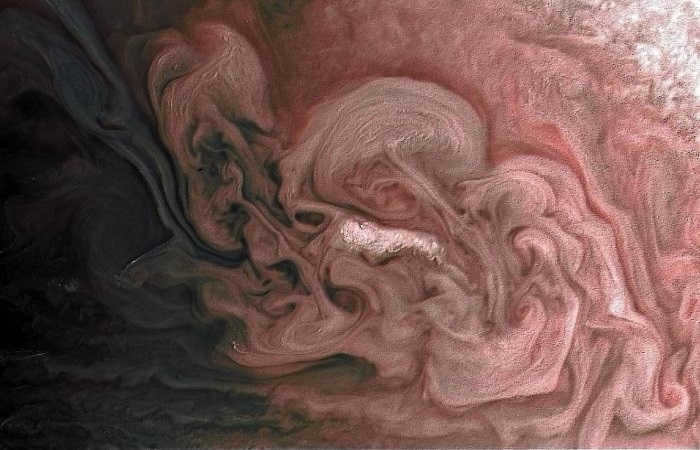
The primary color of this celestial body is orange with some prominent white and reddish-brown features. The orange hue is attributed to the presence of clouds composed of ammonium hydrosulfide in the atmospheric composition. The conspicuous white formations are ammonia clouds, while the reddish-brown spots consist of compounds containing phosphorus, ammonia, and sulfur.
A distinctive characteristic of Jupiter’s appearance is its bands. The exact cause of their formation remains uncertain. It is possible that they originated as a result of “warm” processes occurring in the local atmosphere: certain portions of the air became heated and rose, while other masses cooled and descended. This led to the formation of stable currents.
It is highly likely that the bands formed due to the gravitational influence of Jupiter’s satellites: their attraction created “columns” of air that, due to the planet’s rotation, evolved into striped regions.
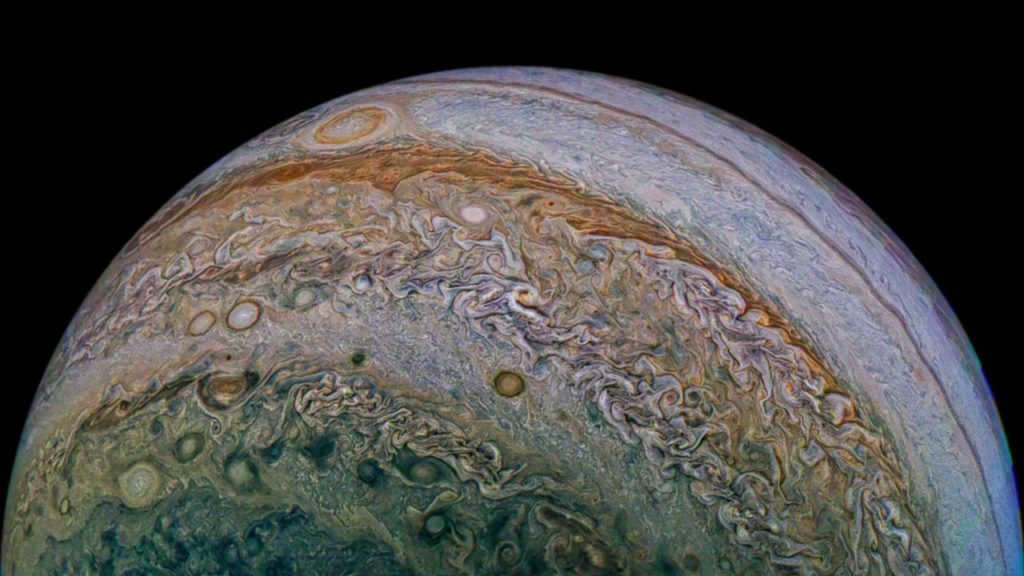
Jupiter is known for its distinctive stripes, which can vary in color and intensity. In some areas, the stripes appear lighter, indicating increased pressure and upward air currents.
The white color of certain objects on Jupiter is attributed to a high concentration of bright white ammonia crystals.
On the other hand, darker areas on the planet are hotter and are dominated by downward flows of red-brown ammonium hydrosulfide crystals.
These bands are not static and undergo constant changes in shape and color. Light and dark areas can shift positions, and some may even disappear entirely. For example, the dark Southern Equatorial Belt, which had been a stable feature on Jupiter for many years, suddenly vanished in 2010.
Recent observations made by the Hubble Space Observatory indicate that the belt has not disappeared, but instead has been concealed beneath a newly formed bright band.
The Great Red Spot
The largest atmospheric anticyclone hurricane in the region of space that has been studied is referred to as the Great Red Spot (GRS). Throughout centuries of observation (initially noted by English inventor and naturalist R. Hooke in 1664, but officially discovered by European astronomer J. Cassini a year later), this area has consistently changed in both size and color.
Over the past century, the GRS has been steadily shrinking:
- During the 1970s-1980s, the hurricane spanned 23 thousand km;
- By 2014, it had reduced to a width of no more than 16.5 thousand kilometers;
- The most recent recorded size measures 13 thousand kilometers.
The size of the object is also gradually getting smaller. Presently, this measurement is between 40,000 and 50,000 kilometers. Furthermore, the BKP used to be more luminous in the past. Nonetheless, despite its decreasing trajectory, the entity continues to be the largest atmospheric vortex object in the entire solar system.

The Juno spacecraft captured an image of Jupiter’s Great Red Spot, a massive storm that is constantly in motion along the planet’s equatorial line. The storm reaches heights of approximately 8 km above Jupiter’s cloud tops and its swirling gas streams rotate counterclockwise, completing a full revolution in about 6 Earth days and moving at speeds of 500 km/h.
While the name suggests its color, scientists have yet to fully understand the exact appearance of the Great Red Spot.
One theory suggests that the area’s reddish hue may be due to the presence of phosphorus compounds in large quantities.
The most powerful occurrence of this nature occurred in 1975, causing the Great Red Spot to lose its intensity and take on a lighter shade for a few years due to its collision with another vortex.
At times, the Bright Knot Phenomenon can be observed through a telescope as a luminous, nearly white entity. Experts posit that this may occur when the Blur ascends to the same altitude as the upper boundary of the atmosphere, essentially “floating” on its surface.
Nevertheless, this phenomenon is short-lived: the power of the hurricane increases almost immediately, the BKP rises to its usual height, and it takes on a characteristic red hue under the influence of ultraviolet radiation from the Sun.
Saturn, a planet adorned with a striking ring system, is at its most stunning when it is closest to the Sun. However, aside from its rings, this celestial body, classified as a gas giant, was discovered by ancient civilizations and named after the ancient Roman god of agriculture, and it possesses other intriguing characteristics.
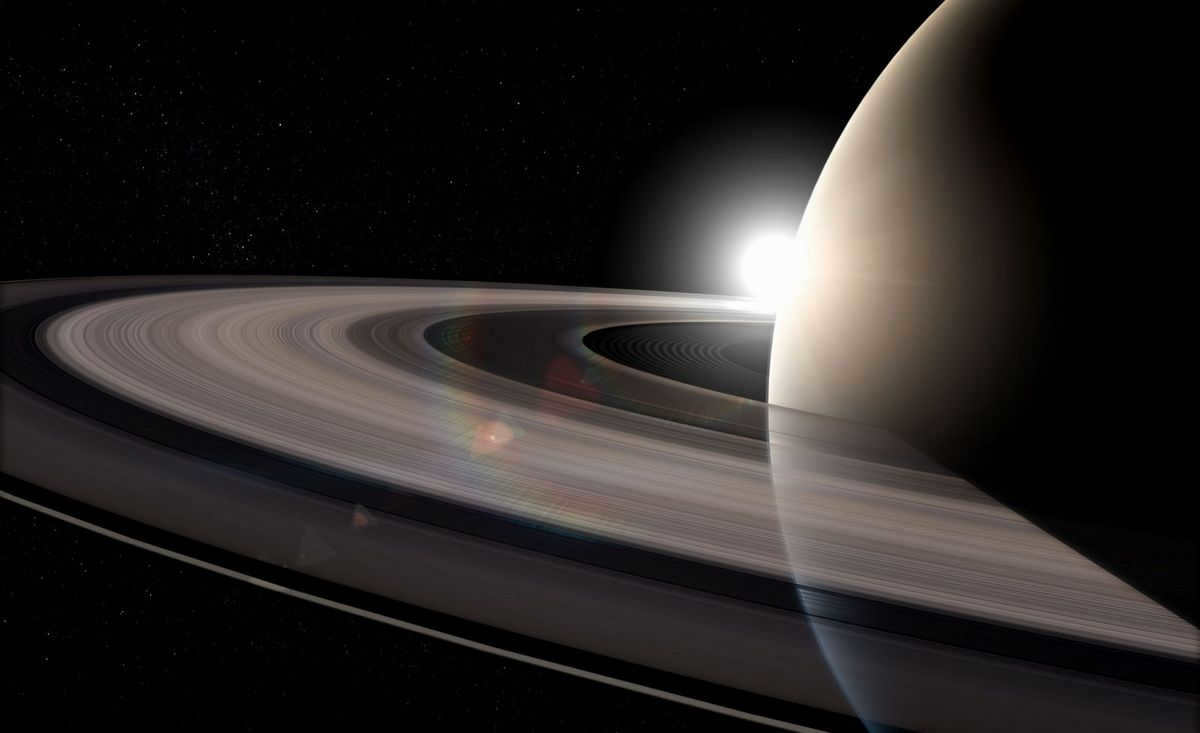
Saturn is the sixth planet from the Sun and the second largest planet in the solar system, coming after Jupiter. Credit: million-wallpapers.ru
Physical characteristics of Saturn
Saturn is the second largest planet in the solar system, with a circumference of 9 times that of Earth and a weight 95 times greater than Earth.
The main features of Saturn include:
- Shape: a flattened spheroid, with the equatorial circumference being significantly larger than the polar circumference.
- Average radius: 58.2 thousand kilometers.
- Mass: 5.68 x 10^26 kg.
- Surface area: 4.3 x 10^10 km².
- Gravity acceleration: 10.44 m/s².
The gravity acceleration on Saturn is almost equal to that of Earth.
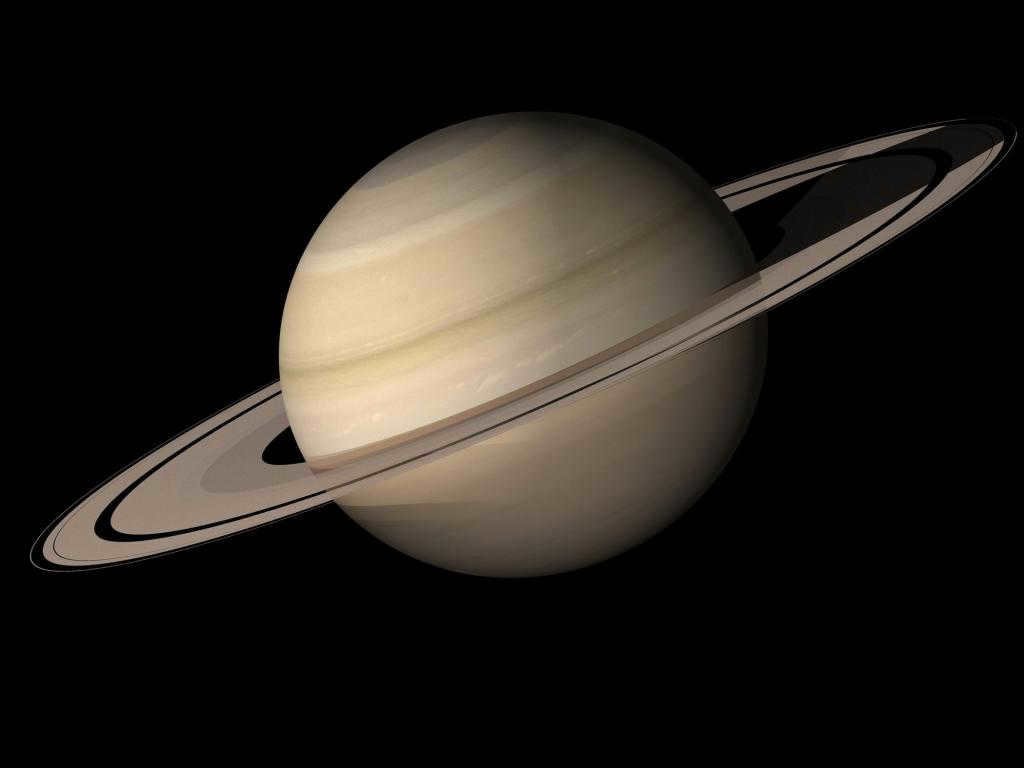
Fascinating fact: Saturn is the only planet in our solar system with a density of 0.687 g/cm³, which is less than that of water.
During most of its orbit, Saturn’s closest neighbor is Jupiter, with a minimum distance of only 655 million km between them. However, during certain periods of the year, these two objects are on opposite sides of their trajectories, and then Uranus, located 1.43 billion km away, becomes the closest planet to Saturn.
Orbit and rotation of Saturn
The average distance from the Sun to Saturn is approximately 1.43 billion km (9.5 astronomical units or 0.00015 light years). Saturn comes closest to the Sun at a distance of 1.35 billion km during perihelion, and moves farthest away at a distance of 1.51 billion km during aphelion. It takes about 1 hour and 20 minutes for starlight (sunlight) to reach Saturn.
Saturn’s orbit has an elongated elliptical shape, and the planet moves along it at a speed of approximately 9.7 km/s. It completes a full revolution around the Sun in almost 29.5 Earth years or 378 local days.
Saturn also rotates on its axis, with a day length of about 10.5 Earth hours. However, different regions of the planet rotate at different speeds, which can be attributed to the predominant presence of gases rather than solid substances in its composition.
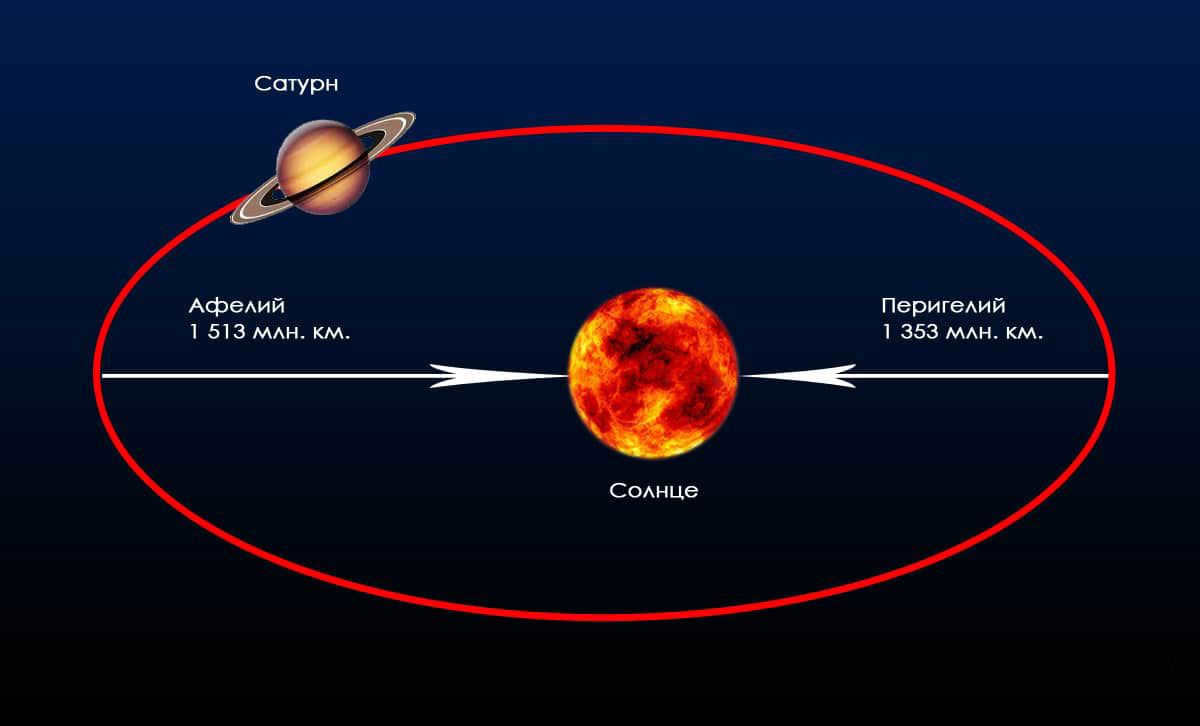
With a tilt of 26.7 degrees, Saturn’s axis is similar to that of Earth. As a result, Saturn experiences seasons, although they are more subtle compared to those on Earth due to its distance from the center of our solar system.
The birth of Saturn occurred approximately 4.6 billion years ago, alongside the formation of other celestial bodies within the solar system. It is plausible that Saturn initially occupied a distinct position within the cosmos, but was subsequently influenced by the gravitational force of Jupiter, causing it to settle into its current orbital path.
An exploration of Saturn’s iconic rings
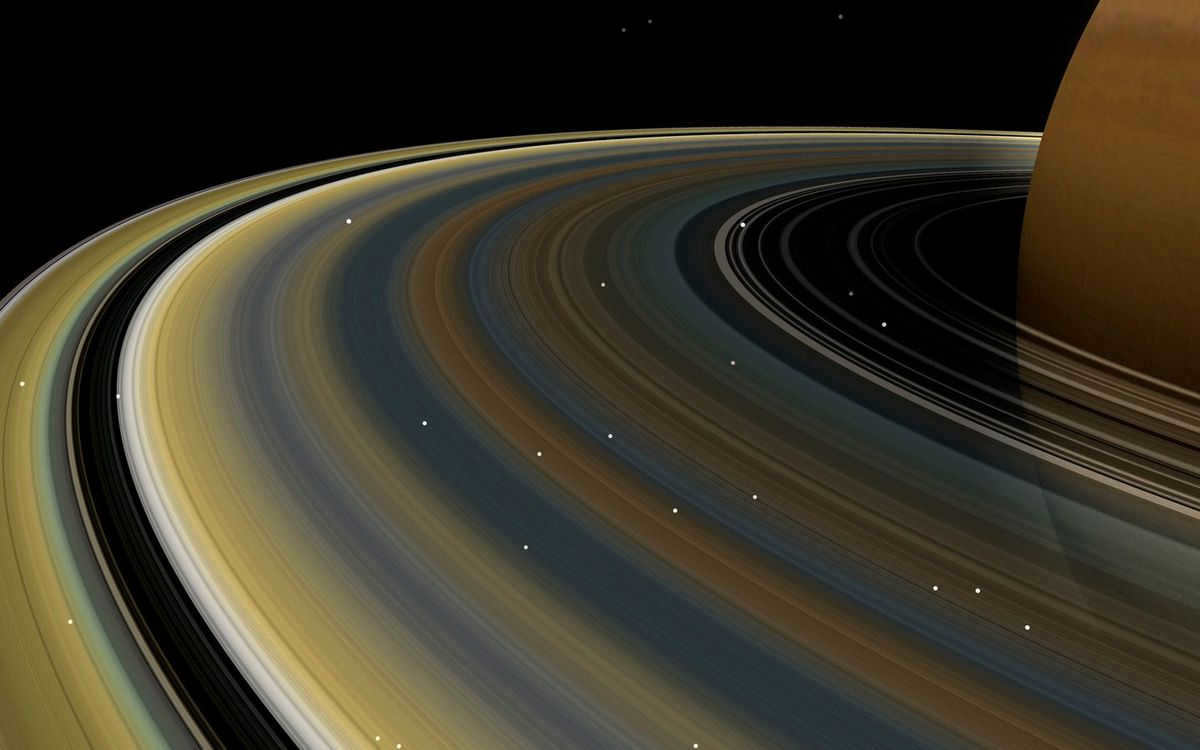
The rings of Saturn are positioned at a 28° inclination relative to the ecliptic plane. When observed from Earth, they appear in their familiar shape and at various intervals. However, due to their unique orientation, they can also be seen from the edge, creating a stunning rib-like appearance. This unusual perspective led to a widespread theory in the early 20th century that the Saturnian rings had somehow vanished into the vast expanse of space. In reality, they were simply not detectable with the astronomical equipment available at that time. Nevertheless, it is inevitable that one day these magnificent rings will cease to exist. In approximately 100 million years, Saturn will engulf and absorb its rings, causing them to disappear forever.
The origin of Saturn’s rings
Scientists believe that Saturn’s rings were formed early in the planet’s history. They are believed to be the remnants of a moon that was approximately 300 km in diameter. This moon was torn apart by Saturn’s gravitational forces, resulting in the formation of the small fragments that now orbit the planet.
There is another theory regarding the formation of Saturn’s ring system. It suggests that the ring’s components were also formed from the gas and dust disk that surrounded Saturn during its formation.
However, both theories face a challenge: the ice in Saturn’s rings is remarkably pure. This purity contradicts the possibility of the rings being billions of years old, as they would have accumulated cosmic dirt over time. It’s possible that the rings have a mechanism for renewing their material, making it difficult to determine their actual age.
Saturn’s inner composition
Saturn possesses a distinctive internal makeup compared to the planets within the Earth group. Researchers hypothesize the presence of a dense rocky core within the planet. Above this core lies the mantle, which can be likened to a viscous mixture of hydrogen and fragments of stone. Finally, we encounter the planet’s atmosphere.
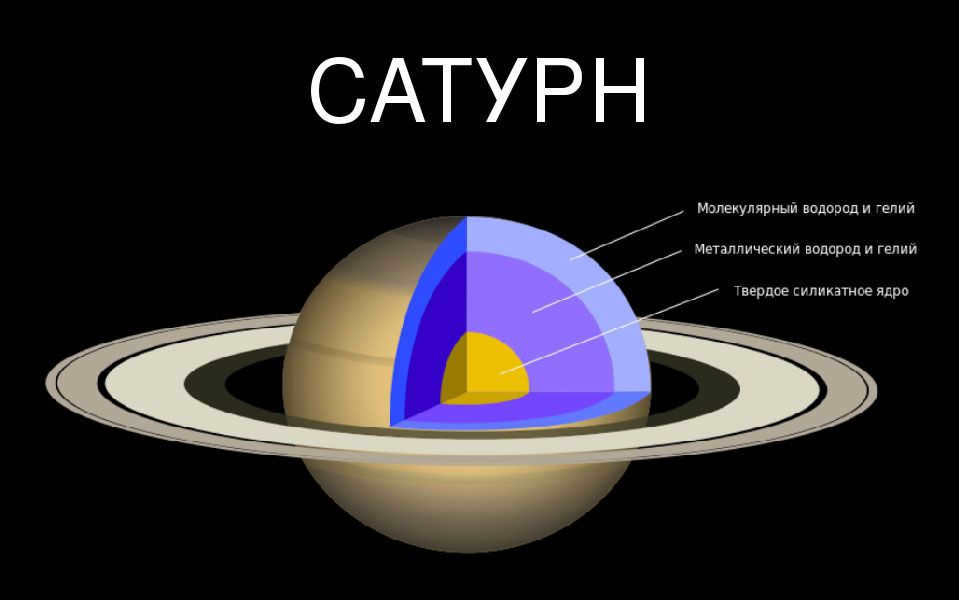
Metallic hydrogen
As we venture deeper into the planet, the temperature and pressure escalate, compelling hydrogen to transition into a fluid state. Once we reach a distance of 30,000 kilometers, the hydrogen undergoes a transformation and becomes metallic.
Atmosphere and temperature of Saturn
The primary constituents of Saturn’s atmospheric composition consist of hydrogen (which accounts for approximately 96% of the overall composition) and helium (comprising roughly 3%). In addition, there are trace amounts of other elements:
These elements contribute to the distinctive vibrant bands and clouds visible on Saturn’s surface.
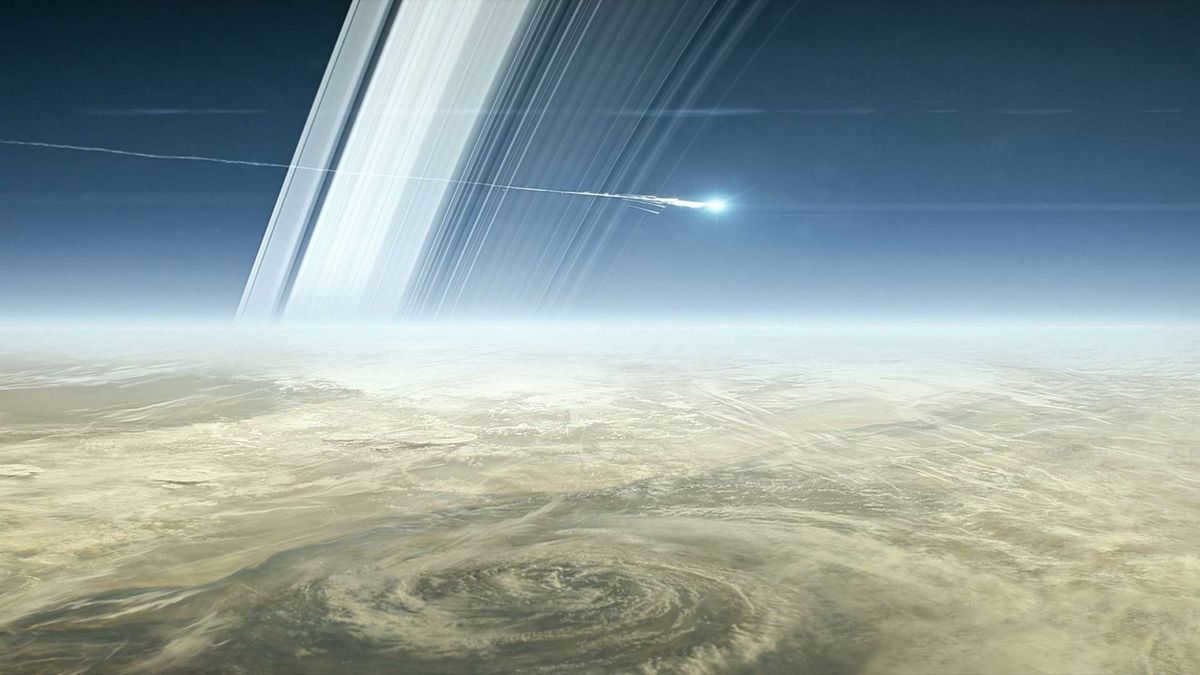

The atmosphere of Saturn is highly dense, with only the uppermost dense layer visible. Credit: astro-world.ru
The uppermost layer of the atmosphere is composed of ammonia, with temperatures ranging from -150…-250°C. Below, the sky is filled with clouds of ammonium hydrosulfide. The warmest temperatures in this region reach -50…-70°C. The deepest clouds contain water in a state between liquid and solid. The temperature here is approximately 0°C.
Atmospheric Winds on Saturn
One of the common occurrences in the atmosphere of Saturn is the presence of powerful and long-lasting hurricanes. These hurricanes have wind speeds that can reach up to 1800 km/h and are primarily found within the bands encircling the planet. These storms can last for several months and are often accompanied by lightning discharges. Eventually, these vortices are absorbed by the planet’s atmosphere.
Hexagon
In telescopes, the hexagon visible in the northern polar region of Saturn is created by clouds. Each side of the hexagon measures approximately 13.8 thousand kilometers, and the cross-section is nearly 25 thousand kilometers. The size of this hexagonal vortex is large enough to fit four planets the size of Earth.
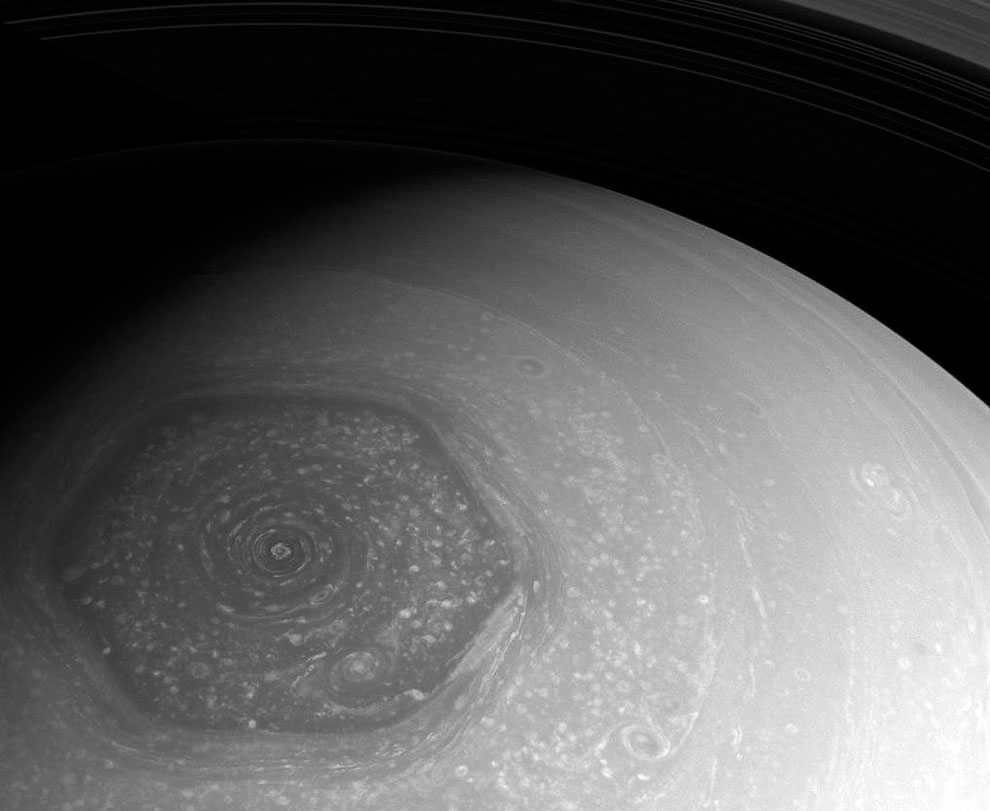
The hexagonal cloudy region was initially observed by the Voyager exploration mission. Subsequently, the cameras of the Cassini spacecraft captured detailed images of this region.
The Structure of Saturn’s Magnetic Field
The existence of metallic hydrogen in Saturn’s composition accounts for the creation of its magnetic field. The influence of the local magnetosphere extends all the way to the orbit of Saturn’s largest moon, Titan, which is situated over 1.2 million kilometers away.
Additionally, this satellite plays a significant role in the creation of ionized particles within the magnetic field, which in turn leads to the formation of vibrant auroras. Specifically, solar radiation particles become trapped within Saturn’s magnetosphere, thereby forming radiation belts. These belts contain ions that travel in an uneducated manner along the force field lines, and upon colliding with the planet’s atmosphere, they generate mesmerizing violet-colored auroras.
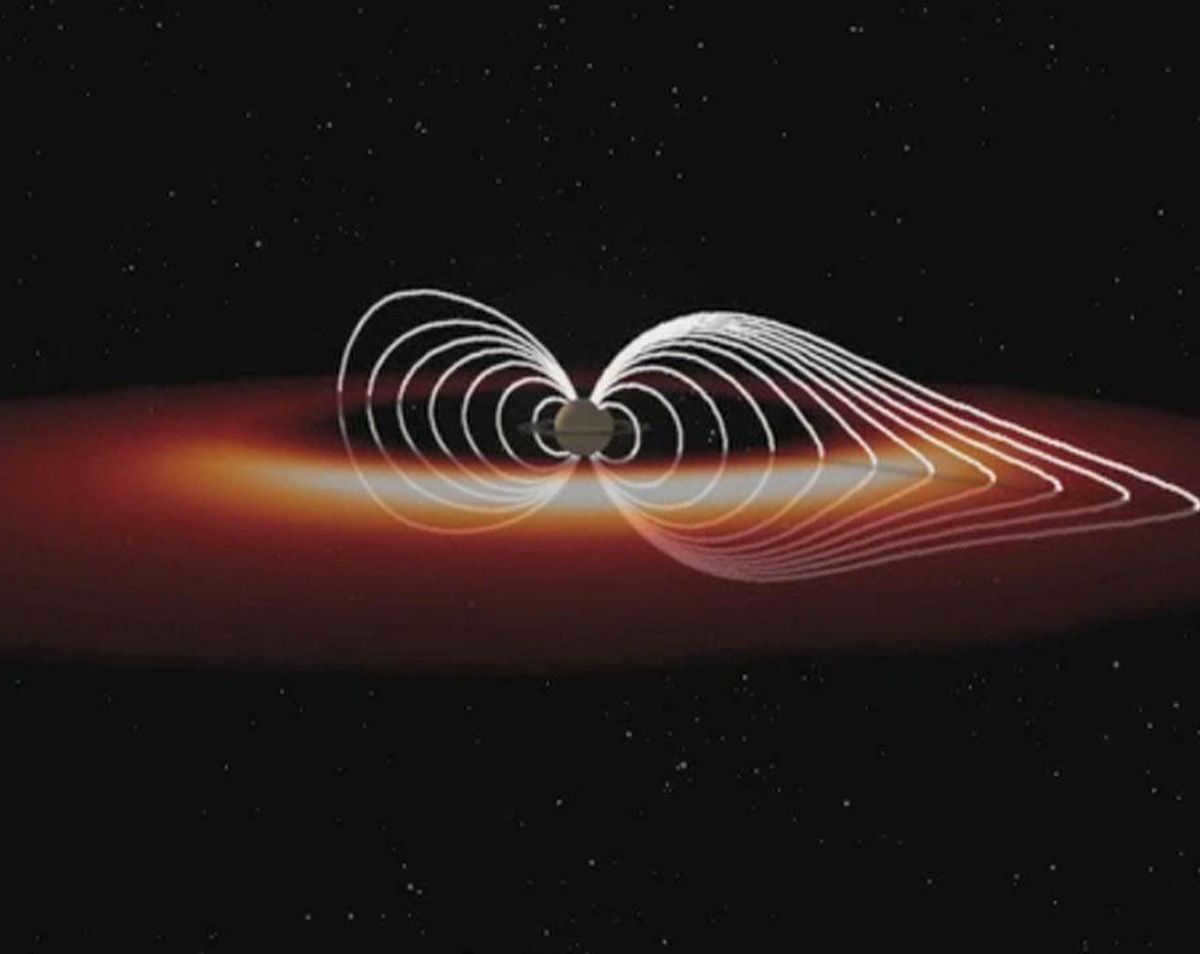
The appearance of Saturn
When observed from Earth, Saturn presents itself as a pale yellow sphere with hints of orange scattered across its celestial canvas. Enhanced telescopes and space-based observatories unveil the intricate layers of white and vibrant orange clouds that envelop the planet, revealing a mesmerizing display of atmospheric storms and patterns.
Similar to its celestial sibling Jupiter, Saturn showcases a delicate striped arrangement on its surface. Though these stripes are slightly more subdued in comparison, they still showcase a mesmerizing array of colors. These bands are wider near the planet’s equator, gradually tapering off towards its polar regions.
Map of the Surface of Saturn
Creating an precise map of Saturn is not feasible due to the lack of a solid surface on the planet. Nevertheless, a rough representation of the planet’s surface has been constructed using photographs captured by spacecraft that came close to Saturn – Pioneer 11, Voyager 1 and 2, Cassini.
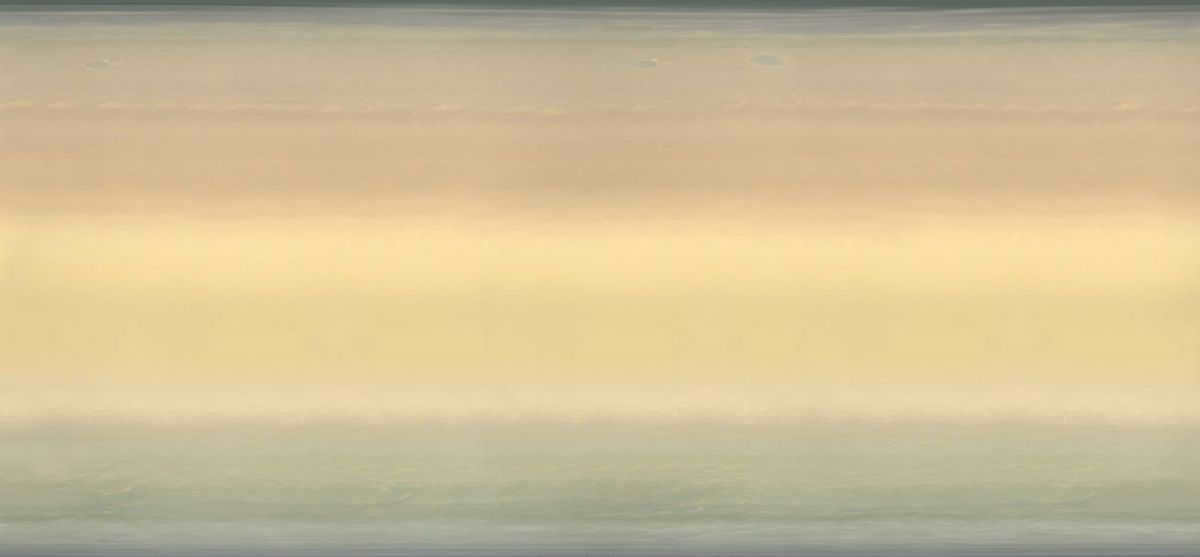
Exploring the History of Saturn
The specific date of Saturn’s discovery remains a mystery. It was in the early 17th century that Galileo Galilei observed Saturn through a telescope. During his observations, Galileo also noticed two unidentified objects near the planet, initially believing them to be satellites. However, it wasn’t until 50 years later that Christian Huygens, utilizing more advanced astronomical technology, determined that these peculiar “companions” were actually part of a delicate, flat ring encircling the planet without making physical contact.
“Pioneer 11.”
This pioneering unmanned spacecraft, known as Pioneer 11, holds the distinction of being the very first to venture close to the majestic planet Saturn. Equipped with advanced technology, this interplanetary station successfully captured breathtaking images of Saturn itself, as well as its largest satellites. Moreover, the groundbreaking mission of Pioneer 11 led to the remarkable discovery of Saturn’s enigmatic F ring, adding to our ever-expanding knowledge of the outer reaches of our solar system.
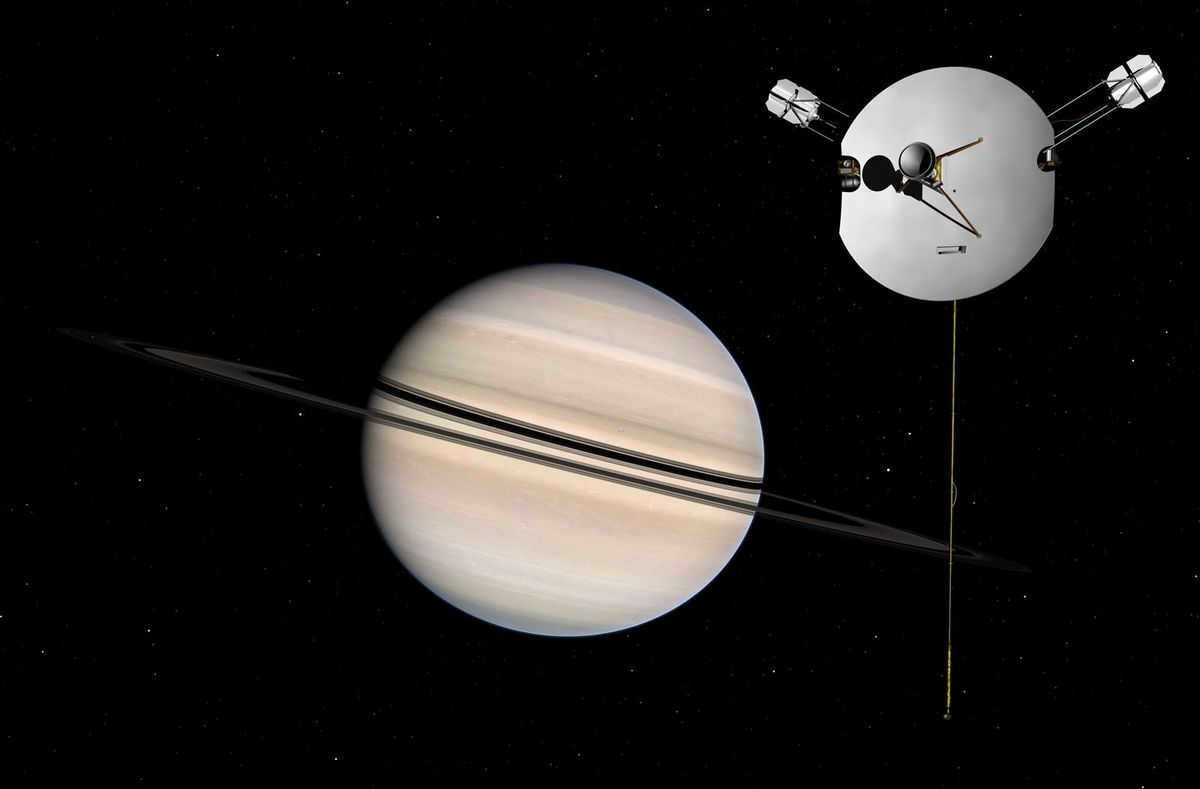

“Voyager 1
Back in 1980 – 1981, Voyager 1 had an incredible opportunity to explore the vicinity of Saturn. During this mission, the spacecraft accomplished several important tasks:
- captured a series of remarkable high-resolution images;
- measured the temperature of the surrounding atmosphere;
- estimated the density of the air enveloping Saturn;
- and gathered valuable data on the planet’s fascinating satellites.
This spacecraft embarked on a journey to the planet immediately following Voyager 1. It conducted a thorough analysis of the chemical composition of the surrounding atmosphere and captured detailed photographs of the Keeler and Maxwell gaps within the ring system.
“Cassini-Huygens”
In 1997, the Cassini-Huygens mission was launched to explore Saturn. After a 7-year voyage, they finally reached their destination. The Huygens module then detached from the spacecraft and descended to the surface of Saturn’s moon, Titan, using a parachute. During the landing, it collected samples of the local air. Meanwhile, the Cassini module remained in orbit around the planet.
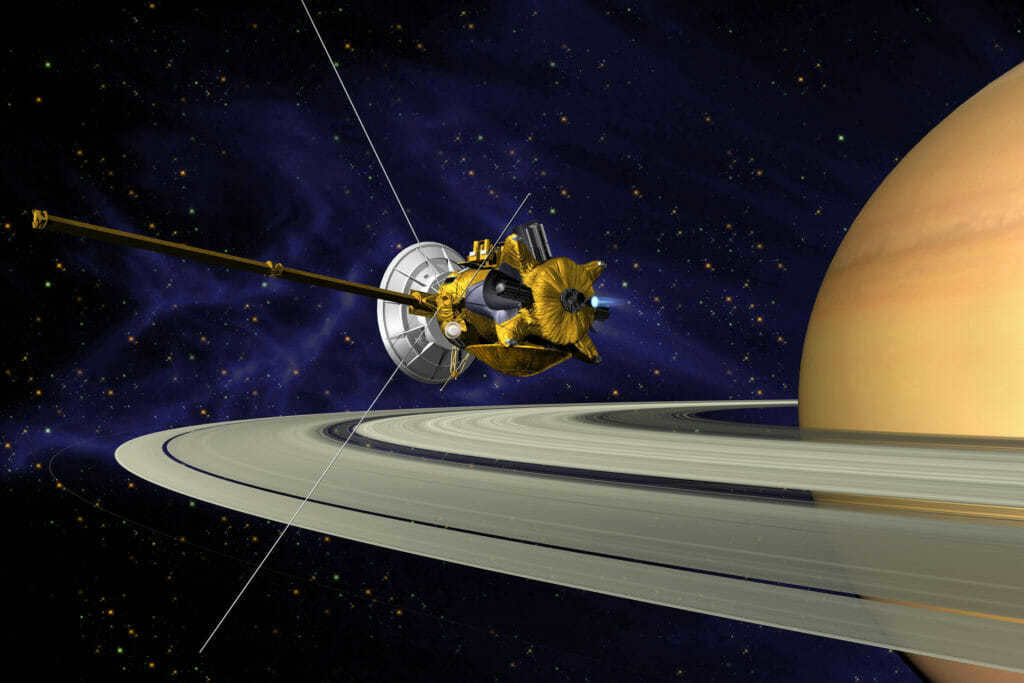
The researchers successfully accomplished their mission in 2017 by sending the spacecraft deep into the atmospheric layers of Saturn.
Upcoming expeditions
In the upcoming decades of the 2020s and 2030s, there are plans to initiate the TSSM research campaign, also known as the Titan Saturn System Mission. The launch window for the spacecrafts is set to open in 2029. It is anticipated that the TSSM mission will span a period of 4 years, with an equal amount of time dedicated to studying both Saturn and its moon, Titan.
There are a total of 62 moons orbiting the planet, but only 53 of them have been given official names. The majority of these moons are too tiny to be seen from Earth, even with the help of a telescope. The Cassini space station was responsible for the discovery of most of these satellites, and they have been named after various ancient Greek titans and titanides.
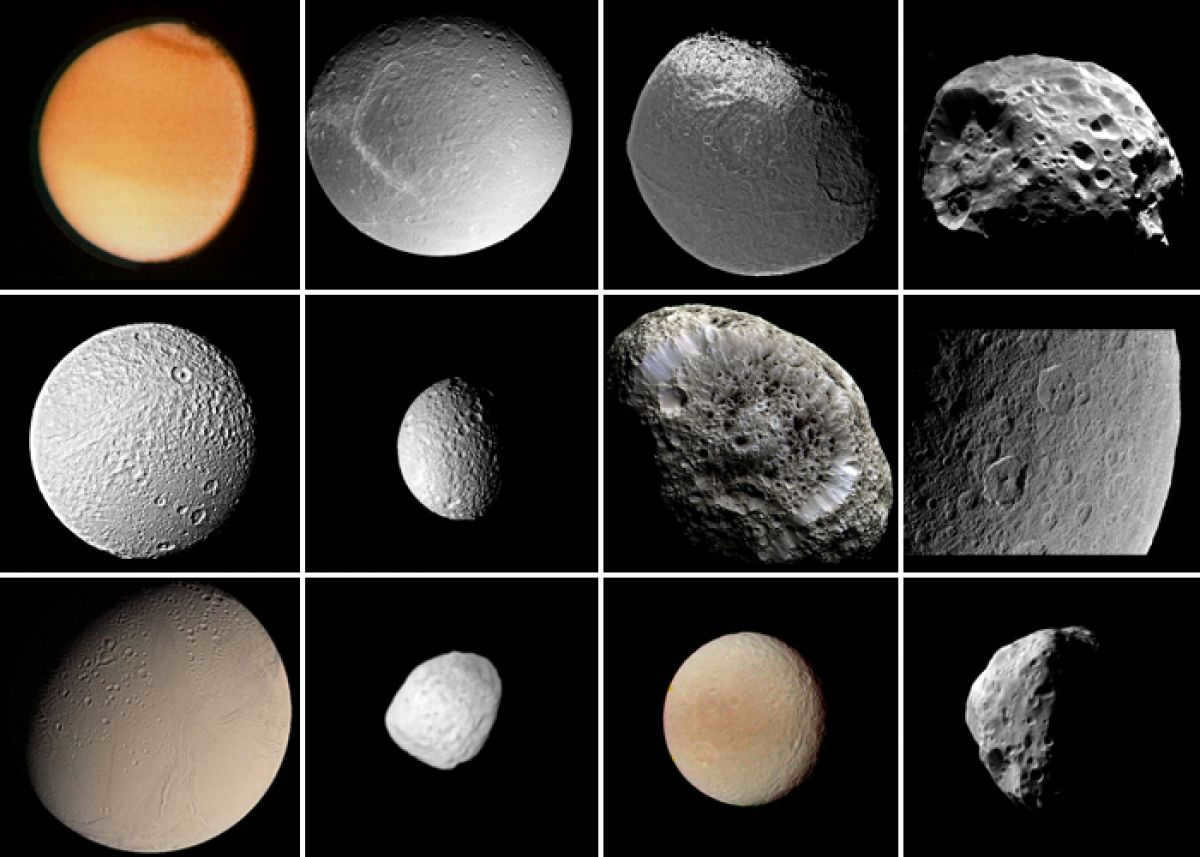
The 4 moons inside Saturn, listed from smallest to largest, are:
- Mimas, a moon that has the shape of an egg and is located only 185 km away from the planet. This close proximity to Saturn results in a short orbital period of less than a day.
- Enceladus, a spherical moon that shows signs of geological activity, as seen from the numerous faults in its south polar region.
- Tefia, a heavily cratered moon that is covered in a large number of hills and has very few plains.
- Dion, a moon with an ancient surface that has been significantly damaged by asteroid impacts and other objects from outer space.
The moons located beyond the E ring are known as the outer moons. The largest among them are:
- Rhea, which has a year’s duration of only 4.5 days.
- Titan, the only Saturnian satellite that has its own atmosphere.
- Hyperion, a sponge-like moon that spins unpredictably.
- Saturn’s irregular satellites are known for their small size.
- These satellites are categorized into three groups: Inuit, Gallic, and Norse (Scandinavian).
- The Norse group is also referred to as the “Thebes family” in honor of its largest moon.
- The smallest satellites of Saturn belong to the Alcoinid family.
Existence on Saturn
Life cannot thrive on the planet due to its inhospitable conditions. Saturn is composed predominantly of hydrogen and helium, making it unsuitable for the emergence and evolution of living organisms. The prevailing temperatures on Saturn are generally low, and even in areas where the temperature may allow for liquid water, the atmospheric pressure is excessively high, comparable to being several kilometers deep in Earth’s oceanic depths.
Enceladus is considered to be one of the potential candidates for harboring extraterrestrial life. This moon displays the presence of ice geysers that reach heights of tens and hundreds of meters, suggesting the existence of liquid water on its surface.
A different moon, Titan, has deepened relief features that contain large reservoirs of liquid hydrocarbons. These hydrocarbon deposits provide a potential environment for the emergence of life in the future. Titan bears resemblance to early Earth, and in a few billion years, when the Sun transitions into a red dwarf, the temperature on Titan may become suitable for supporting life. The local hydrocarbons, particularly complex hydrocarbons, could serve as the primary components for the development of life on this moon.
Saturn vs Earth: A Comparison
When it comes to comparing Saturn to Earth, the numbers are truly mind-boggling. For instance, Saturn’s diameter is nearly 10 times larger than that of our planet, making it seem like a giant in comparison. In fact, if we were to place 760 Earth-sized planets inside Saturn, they would fit comfortably within its vast expanse. However, instead of relying solely on numbers, it’s much more impactful to see a visual representation of Saturn and Earth side by side, allowing us to truly grasp the scale of these celestial bodies.
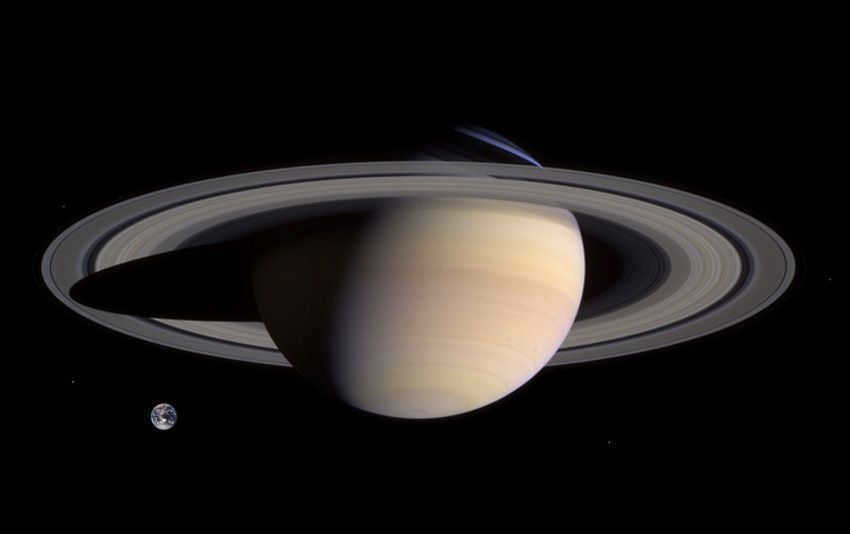
Isn’t that remarkable? To put it differently: let’s juxtapose Saturn with the Earth-Moon distance! It appears like this:
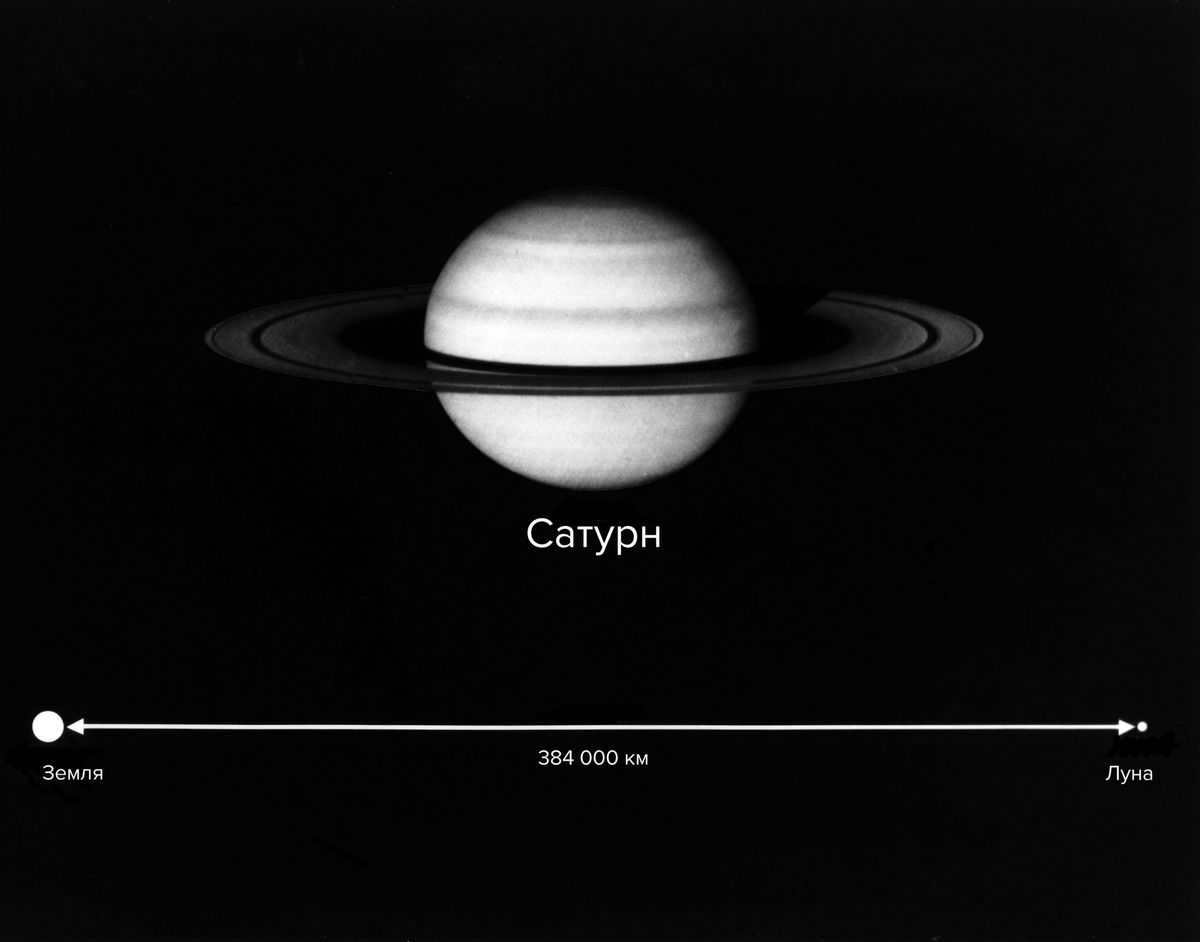
Saturn Won’t Sink in Water
While it may seem unlikely, Saturn’s average density is actually lower than that of water (0.69 g/cm³ vs. 1 g/cm³)! If there were a massive ocean in the vast expanse of the Universe where Saturn could be immersed, the planet would effortlessly float, submerged just over halfway. How can this be? Unlike Earth or Mars, Saturn is not composed of solid rock. It consists of gases. Moreover, it is comprised of the lightest gases found in nature – hydrogen and helium. These gases are intensely compressed under immense pressure deep within the planet, transitioning first into a liquid state and then into a metallic form. Nevertheless, they remain the same hydrogen and helium! The solid core is positioned at the very center of the planet and weighs merely 10 to 20 times that of Earth.
Do you ever wonder why Saturn appears different in shape compared to a perfect sphere in all the images? It’s almost as if the planet was put on a colossal anvil and struck forcefully with an enormous hammer at its poles. This is not an optical illusion or a flaw in the photographs – Saturn is actually compressed at its poles!
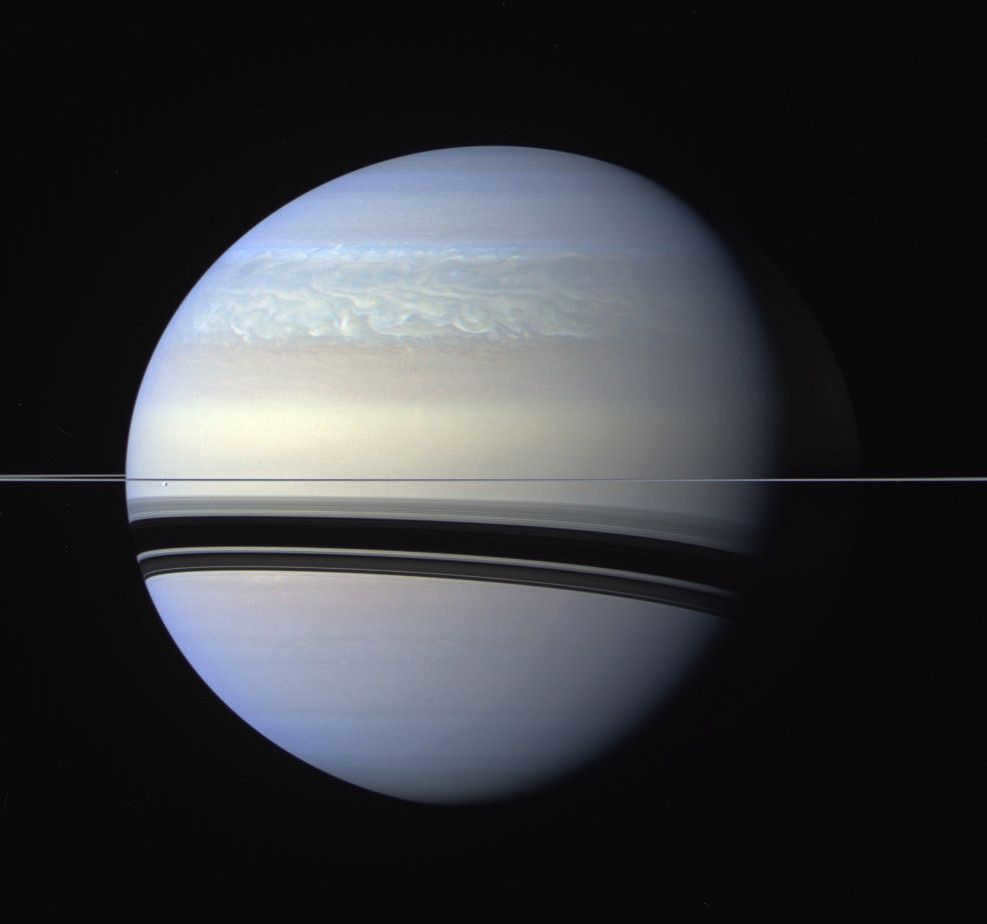
The diameter of Saturn’s poles is 1/10th smaller than its equatorial diameter. This is equivalent to a whole cross-section of the Earth! The reason for Saturn’s significant flattening is its fast rotation on its axis. Saturn completes a full rotation in just 10.5 hours, resulting in the equatorial regions rotating at nearly 10 kilometers per second. Additionally, the low density of the rotating matter and the resulting centrifugal forces at the equator cause the gas to be noticeably pulled apart. However, if the Earth were rotating at the same speed, it would not be as compressed as Saturn. This is due to the fact that our planet is composed of denser materials such as rock and metals. The concentration of mass towards the center of the Earth is less pronounced compared to Saturn, resulting in less compression, although still noticeable.
Here’s an interesting tidbit: due to the fact that a year on Saturn is equivalent to 30 Earth years, the duration of its seasons is extended by a factor of 30, which means they last for a whopping 7.5 years!
Saturn’s interior is scorching
Saturn is located approximately 10 times farther away from the Sun compared to Earth. As a result, the temperature on Saturn is extremely cold! The surface temperature of Saturn, which is visible from Earth and consists of a layer of clouds, is around -180° C. However, there is a fascinating fact about Saturn’s heat emission: it radiates almost 2.5 times more heat than it receives from the Sun. This phenomenon can be explained by the internal heating of Saturn. Scientists propose that at a depth of 45,000 kilometers beneath the cloud layer, the temperature reaches a staggering 10,000 degrees! In the core of Saturn, the temperature ranges from 12,000 to 15,000 degrees. The planet’s temperature is sustained by its gradual compression. As the gas that comprises Saturn cools down and releases heat into space, its pressure decreases, causing it to descend towards the planet’s center due to gravity. As the gas descends, it becomes denser, resulting in increased pressure and temperature. This process can persist on Saturn for billions of years. Simultaneously, the planet gradually shrinks in size and its density rises.
Calculations indicate that the compression process of the planet is insufficient to fully account for the flow of heat emanating from Saturn’s interior. Therefore, theoretical astronomers have proposed a fascinating mechanism. Deep inside Saturn, beneath the immense pressure of the layers above, helium gas undergoes condensation into minuscule droplets. Helium is known to be denser than the predominant element in Saturn, hydrogen. Consequently, the helium droplets descend akin to rain through the hydrogen layer until they reach the planet’s core. As a result, the potential energy of the droplets is converted into thermal energy, contributing a few degrees to the overall temperature of the planet.
Polar Lights on Saturn
Aside from the seasonal changes, Saturn shares another similarity with Earth – the presence of the aurora borealis! These mesmerizing lights are almost as frequent on Saturn as they are on our own planet. However, unlike on Earth, the polar lights on Saturn are captured not in visible light, but in ultraviolet light. The resulting images are then layered on top of a regular photograph of the planet, creating a captivating visual spectacle like the one shown here.
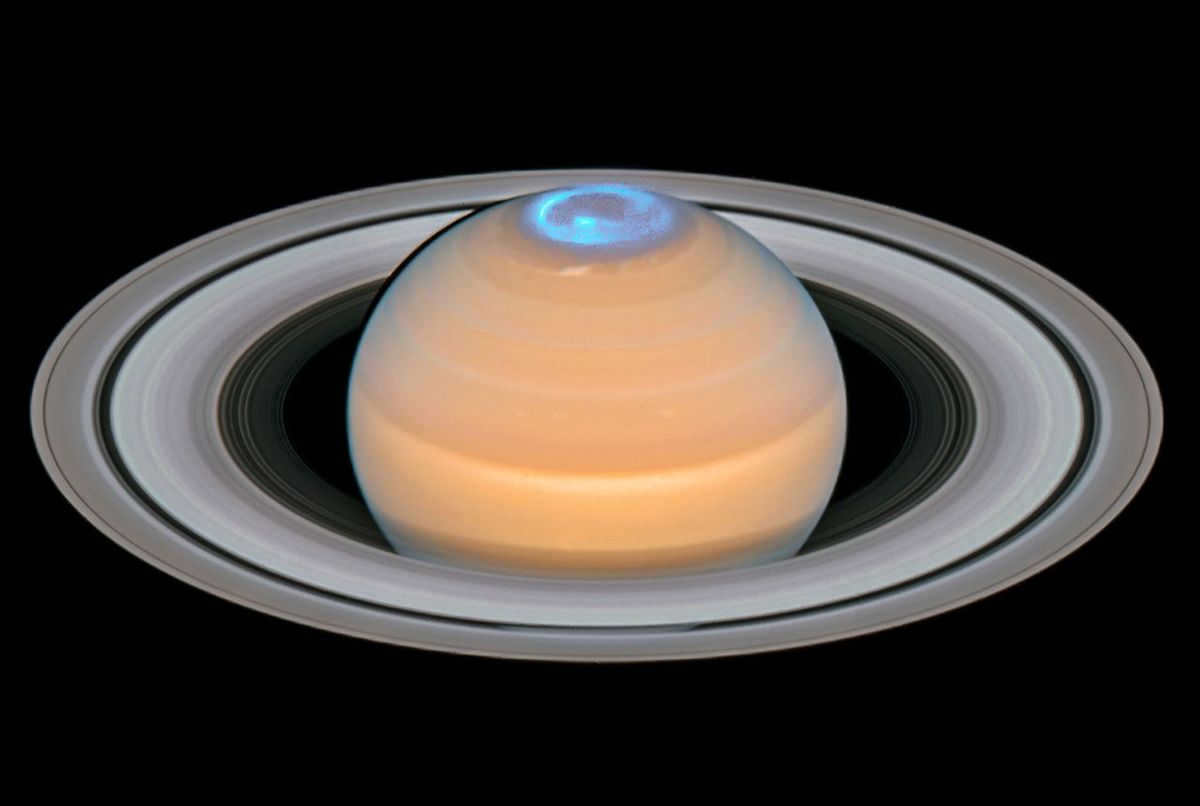
However, this particular photograph captured by Hubble in 1997 exhibits the simultaneous presence of both the aurora borealis and aurora australis.
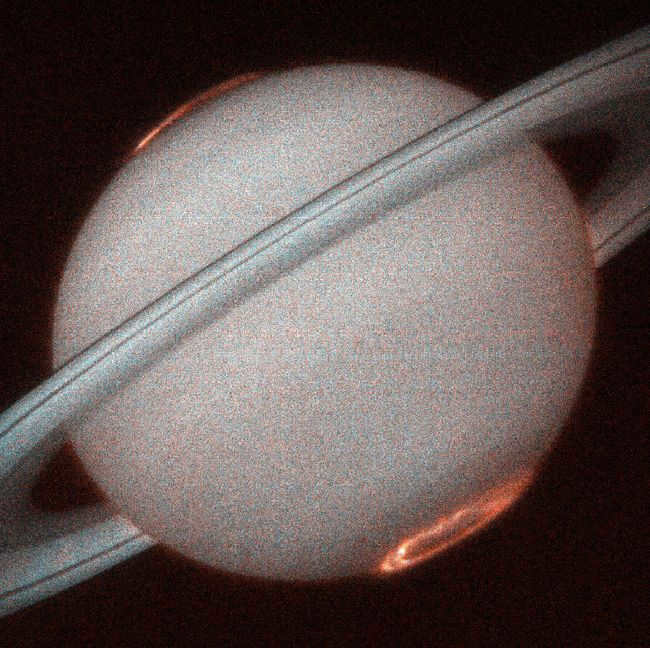
The rings of Saturn cannot be seen from every point on the planet
Saturn’s rings are not made of solid material
Despite the appearance of solidity in the high-quality images captured by the Cassini spacecraft during its decade-long orbit around Saturn, the planet’s rings are actually not solid. While these images do reveal the intricate structure of the rings, they still give the impression of a solid object, reminiscent of a vinyl record.
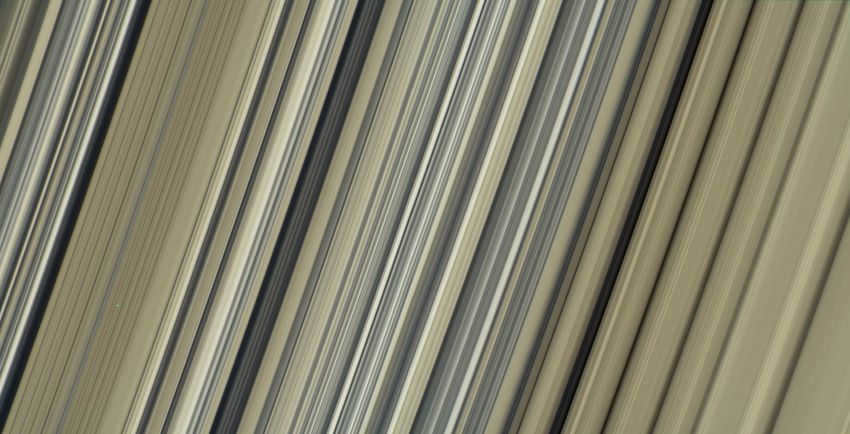
Life Could Exist Near Saturn
Here’s an interesting fact about the Saturn system. Currently, Earth is the only known place in the solar system where life exists. However, scientists are actively searching for other potentially habitable locations within our celestial neighborhood. In order for life to thrive as we know it, liquid water is crucial. Unfortunately, Mars, Venus, and Mercury either lack or have very little liquid water. Saturn itself also lacks liquid water. However, there is a small moon orbiting Saturn called Enceladus that may hold the potential for life. Enceladus is completely covered in ice, but it has cracks through which water shoots up into space, resembling geysers. This suggests that there is liquid water beneath the icy surface of Enceladus, which could make it a viable environment for life to exist.
Saturn is the farthest planet that was familiar to ancient civilizations. When observed in the night sky, Saturn appears as a luminous star that gradually traverses the constellations of the Zodiac. The ancient Greeks bestowed the planet with the name of Cronus, the deity associated with agriculture. Cronus, who was the progenitor of Zeus and the initial ruler of Olympus, is perfectly aligned with Saturn in the Roman pantheon of gods, hence the modern name of the planet.
- Saturn is an enormous planet that consists mainly of the light gases hydrogen and helium. Therefore, Saturn is classified as a gas giant. The planet Jupiter also falls into this category.
- Saturn has a equatorial diameter that is 9.5 times larger than Earth’s. Additionally, Saturn’s mass is 95 times greater than that of our planet.
- Saturn has a volume that is 763.6 times larger than Earth’s!
- The average density of Saturn is only 0.69 g/cm³, which is lower than the density of water. If there were an ocean in the Universe big enough to hold an entire planet, Saturn would float in it!
- Saturn’s surface is a region in the atmosphere where the pressure is 1 bar or 750 mm of mercury. Unlike Earth or Mars, Saturn does not have a solid surface.
- The duration of a year on Saturn is 29.7 Earth years! This is the amount of time it takes for the planet to complete its orbit around the Sun in its massive orbit.
- Saturn has more than 80 satellites in orbit. The majority of these satellites are irregularly shaped ice floes and rocks that range in size from 2 to 10 kilometers. However, there are also exceptional satellites. One of them is Titan, which is the only satellite in the entire solar system to possess a dense atmosphere. Titan has a larger diameter than the Moon and even surpasses the planet Mercury in size.
- Saturn is renowned for its expansive and luminous rings. These rings encircle the planet from all sides and can be observed using a basic amateur telescope. However, when viewed through a small instrument, the rings all blend together into a single ring. It is definitely worth taking a look at Saturn through a telescope at least once!
Just like all the other planets in our solar system, Saturn revolves around the Sun. The average distance between Saturn and the Sun is approximately 9.58 astronomical units.
Let’s remember that an astronomical unit represents the average distance between the Earth and the Sun, which is approximately 150 million kilometers. As a result, Saturn is, on average, 9.58 times farther away from the Sun compared to our planet, at a distance of around 1 billion 433 million 700 thousand kilometers!
But why is it said to be “on average”? Well, that’s because Saturn’s orbit is not a perfect circle. It is slightly elongated, taking the form of an ellipse. The measure of this elongation, or eccentricity, for Saturn’s orbit is 0.056. This means that the distance between Saturn and the Sun varies, fluctuating between 9.048 a.u. and 10.116 a.u. – which is more than one astronomical unit!
The Velocity of Saturn’s Movement
The rate at which Saturn moves is relatively relaxed. Its typical orbital velocity is 9.69 km/s, which is about three times slower compared to the Earth.
The reasoning behind this is straightforward: as per the law of universal gravitation, the velocity of Saturn’s orbit around the Sun is solely determined by the distance between the Sun and the planet, and is not influenced by the planet’s mass.
The orbits of Jupiter and Uranus are closest to Saturn’s orbit. Jupiter, as the fifth farthest planet from the Sun, is closer to the star than Saturn. On the other hand, Uranus, which is the seventh planet, is farther away. While they can be considered Saturn’s neighbors, they are not always the closest planets to it. This is because all planets have different-sized orbits and travel at different speeds around the Sun. As a result, Jupiter and Saturn, or Saturn and Uranus, can often be far apart or on opposite sides of the Sun. In such cases, Saturn’s neighboring planets change.
Ancient astronomers were the first to discover the orbital period of Saturn. They believed they had found the period of the planet’s orbit around the Earth. How did they accomplish this? Quite simply, they closely observed the planet. All planets move across the sky in relation to the background of stars. Saturn, however, moves at a much slower pace compared to other planets that can be seen with the naked eye.
It takes Saturn nearly 30 years to complete a full orbit around all the constellations of the Zodiac and return to its original position relative to the stars. To be more precise, it takes 29 years and 8 months!
This length of time represents the duration of Saturn’s orbit around the Sun, which is known as 1 Saturnian year.
Here is the information on Saturn’s orbit, its speed, and the time it takes to rotate on its axis compared to Earth.
* – data from coordinate system III (from a radio source at 80°N).
The Composition of Saturn’s Atmosphere
The atmosphere of Saturn is primarily made up of hydrogen and helium, which account for 99.5% of its composition. These two elements are the lightest in the entire universe. The remaining less than 1% is composed of various other gases, including methane (no more than 0.4%), ammonia, ethane, phosphine, acetylene, and more.
When observing Saturn, we are not actually seeing its surface, but rather the upper layers of its atmosphere. This atmosphere is incredibly thick, extending thousands of kilometers deep into the planet. The surface that we perceive is actually a dense layer of cloud cover. Saturn’s clouds come in a range of colors including yellow, brown, orange, gray, and even white. When combined, these clouds create the distinct bluish-yellow hue of the planet.
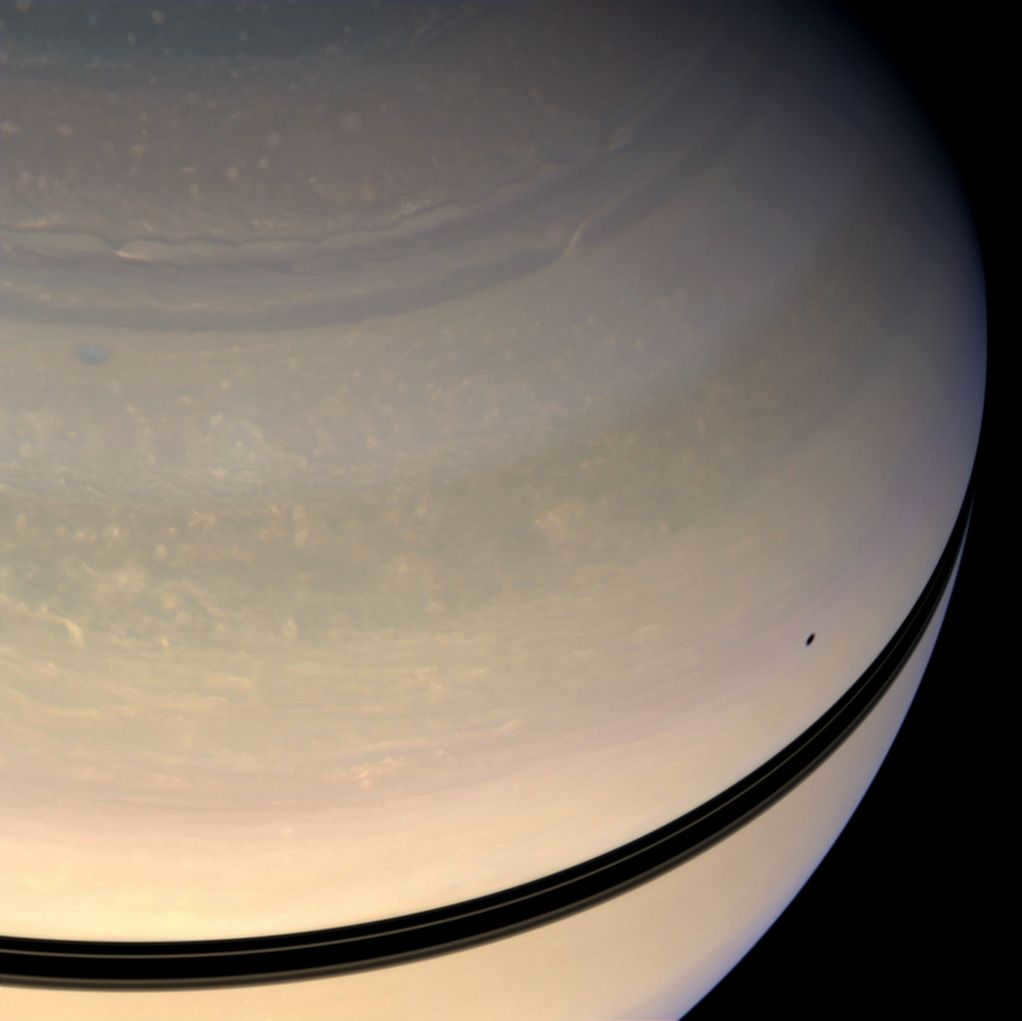
Saturn’s atmospheric conditions are in a constant state of flux. Even amateur stargazers can track its ever-changing dynamics, although not with the same level of specificity as professional astronomers. To observe Saturn effectively, you will require a telescope with a lens diameter of at least 150 mm, favorable weather conditions, and a healthy dose of enthusiasm. It is highly recommended to maintain a journal of observations and create sketches of your findings when embarking on a Saturn-watching journey, as this practice has proven to be immensely valuable.
The article titled “Saturn’s Atmosphere” delves into the intricate chemical composition of Saturn’s air and provides various physical characteristics of the planet’s ringed atmospheric envelope.
Due to the fact that Saturn is not a solid object, different parts of the planet rotate at varying speeds. As a result of this, there are three distinct regions on the planet.
The initial region – known as the equatorial region – completes one full rotation every 10 hours and 15 minutes. This is the duration of a day at Saturn’s equator. This region is referred to as coordinate system I.
The second region is located at higher latitudes both to the south and north of the equator. The rotation period for this region is 10 hours and 38 minutes (coordinate system II).
Lastly, the third region determines the rotation period of an enigmatic radio source situated near the planet’s northern pole. This period lasts for 10 hours, 39 minutes, and 15 seconds (System III).
By knowing the equatorial radius of Saturn and the rotation period of region #1, one can easily calculate the rotational velocity of the planet at the equator. The value is 9.87 km/s or 35,500 km/h.
The internal structure of Saturn
As mentioned earlier, Saturn is a gas giant and lacks a solid surface. Any attempt to land a spacecraft on Saturn would be unsuccessful. On the other hand, the planet cannot be traversed like a cloud either!
As one delves deeper into Saturn, the atmospheric pressure increases to the point where the gas transforms into a liquid.
Approximately one-third of the way from Saturn’s surface to its core, the atmosphere undergoes a remarkable transformation. The intense pressure from the gas above compresses the atmosphere to such an extent that it transitions into a liquid state. At this point, the hydrogen in the atmosphere takes on metallic properties and becomes a conductor of electric current. Scientists refer to this phenomenon as “metallic.”
It is believed that at the very center of Saturn lies an incredibly dense, hot, and solid core composed of iron, nickel, and various types of rock. The mass of this core is several times greater than that of the Earth. Unfortunately, no spacecraft has been able to reach this core to confirm its existence.
With its immense size, Saturn should theoretically possess a formidable gravitational field. In reality, this holds true as the escape velocity is 25.5 km/s. This indicates the speed that a spacecraft needs to achieve to launch from the planet’s non-existent surface and enter into orbit around Saturn. It is three times higher than Earth’s escape velocity.
Alternatively, if Saturn had a solid surface at the same level as its observed clouds, humans could stroll, sit, and recline on this surface without any fear of being crushed by gravity. The acceleration due to free fall on Saturn is 10.44 m/s², which is only slightly greater than Earth’s 9.81 m/s². Moreover, at the equator, it is even lower than Earth’s due to centrifugal forces!
This acceleration is dictated by Saturn’s vast dimensions and low density.
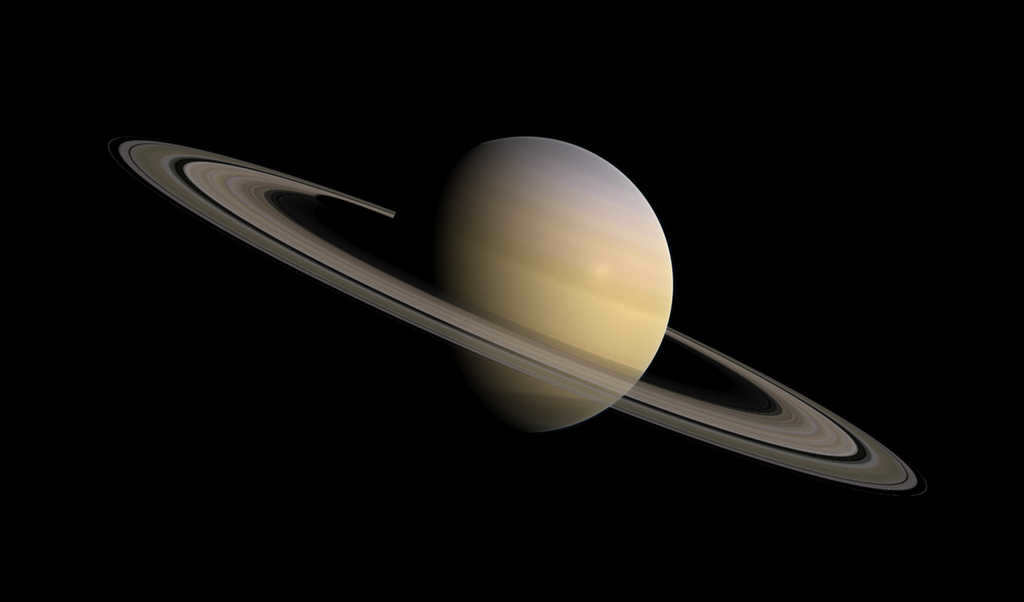
The remarkable, bright, and broad rings are the primary adornment of Saturn. They were initially observed by Galileo Galilei in 1610 while observing the planet through the inaugural telescope. However, the eminent scientist did not fully comprehend what he was seeing. Due to the inadequate optics and a mere 32x magnification of Galileo’s telescope, he perceived peculiar elongations and protrusions on the planet’s sides instead of the rings. Galileo mistakenly believed that he was observing Saturn’s satellites.
The revelation that Saturn is encircled by a ring was made by the Dutch scientist Christiaan Huygens in 1655. Subsequently, the Italian astronomer Domenico Cassini observed a gap, a fissure in the ring, which was subsequently named after him.
The A ring and the B ring are the two distinct parts of Saturn’s ring. It was later discovered that Saturn’s ring is composed of numerous narrow rings.
Despite the rings’ width being larger than the Earth’s diameter, their average thickness does not exceed 150 meters! These rings consist of dust, ice flakes, and contaminated snow particles, each revolving in their own orbit around Saturn in the planet’s equatorial plane. During their journey, they often collide, break apart, and shift from one orbit to another. The average size of these particles is only a few centimeters, although there are also clusters as large as 10 meters in diameter.
Saturn has a large number of satellites orbiting around it. As of 2021, there are 82 satellites in total. These satellites vary in size, with the smallest one being 300 meters in diameter (S/2009 S 1) and the largest one being 5150 kilometers in diameter (Titan). The majority of these satellites are irregularly shaped and composed of a mixture of ice, snow, and dust.
Out of the 82 satellites, five of them have a cross-section larger than 1000 kilometers, while another seven have cross-sections ranging between 100 and 500 kilometers.
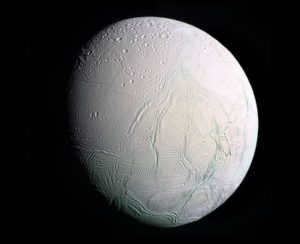
Saturn’s moons are highly notable. Enceladus is a spherical object with a diameter of 499 kilometers. Astronomers have frequently observed water geysers erupting from fissures in Enceladus’ icy surface. Today, it is widely accepted that there is a subsurface ocean of liquid water on this moon.
Titan, Saturn’s largest moon, is a fantastical realm. It is encompassed by a dense nitrogen atmosphere reminiscent of Earth’s. Its surface is blanketed with snow, rivers, lakes, and even seas. However, these bodies of liquid are not composed of water but rather simple organic compounds like methane, ethane, and propane. Similar to Earth, Titan experiences seasonal changes, precipitation, and the formation of clouds and cyclones. All of this occurs at a frigid temperature of -180°C!
There are numerous tiny satellites that roam both on and within the rings of Saturn, providing the rings with stability through their gravitational force. These particular satellites are known as shepherd satellites.
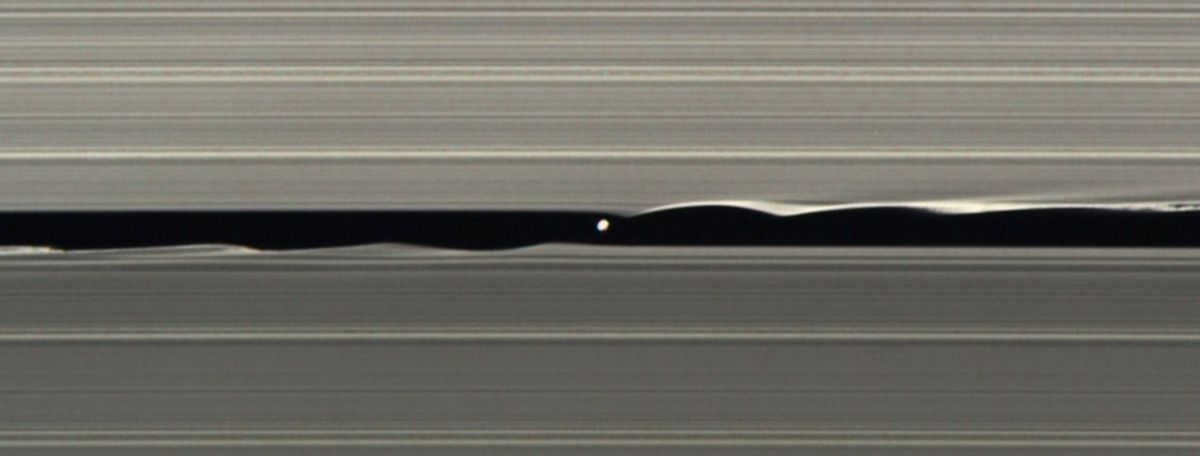
The Saturn system is an extraordinary, captivating, and enigmatic realm that necessitates further exploration.
Genesis of Saturn
In broad terms, Saturn came into being alongside the Sun and the other planets of the solar system from a singular cloud of gas and dust. However, delving deeper into this inquiry, it should be noted that the protosun materialized first within the contracting cloud, followed by the formation of a gas disk encircling the protosun, and only then did the planets begin to take shape within the disk.
Based on prevailing theories regarding the origin of the solar system, Saturn and Jupiter emerged approximately 100 million years prior to the formation of the Earth-group planets. Consequently, Saturn can be deemed marginally older than Earth.

